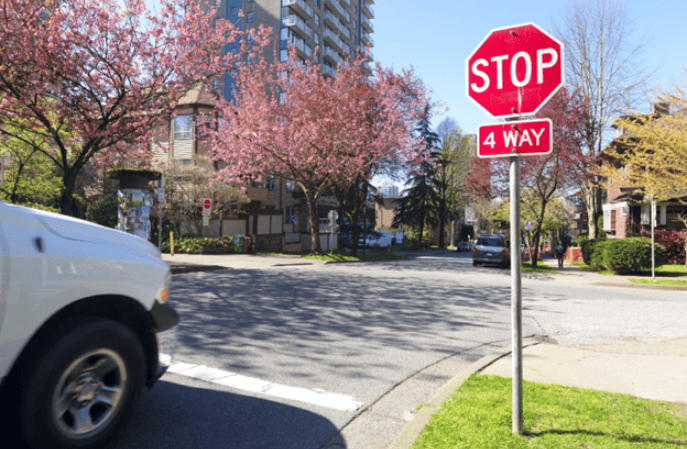- Need Any Help: +1 647-760-5505 or
- info@trubicars.ca
Learning to drive takes time, patience, and a lot of knowledge. There is a lot of information to learn from the Official Driver’s Handbook to begin learning how to drive, but having practical experience is often seen as just as important, if not more important. Attempting to implement everything you’ve learned can be tough to do at times.
One of the confusing rules involves the right of way at an intersection. Trubicars is here to help clarify this law so you can make safe decisions on the road.
One of the things that can confuse many people is the right-of-way rules. These rules were to be a simple law, but as time passed, it seems there is a little bit of confusion in the minds of other drivers. Time has created new procedures that are not part of the rules. Sometimes, the advice seems to be the opposite of what the right-of-way rule says.
Some of the confusion may come from the parents, family, and friends of new drivers. These are often the same drivers who seem confused about how the right of way may work and pass on their confusion to new drivers. They may not feel confused, but their understanding is somewhat confusing.

In many jurisdictions, there are two basic rules for having the right-of-way. The first person who arrives and stops their vehicle at the intersection should be given the right of way and be allowed to go first. If two vehicles arrive and stop at roughly at the same time, the driver to the most right should be given the right of way, and they should be allowed to go first.
As said, those are the basic rules, but there are a few additional rules all drivers should be aware of.
We should also remember that cyclists are vehicles on the road. If they arrive and stop at the intersection first, they should be allowed to go first. Cyclists must follow the rules of the road in all the same aspects as drivers, so we should remember that. Although your vehicle can move quicker when leaving from a stopped position than a cyclist can, it should not mean you should go first. Following the same rules can help keep everyone safe.
It would be good to remember that the few seconds it may take the cyclist to move through the intersection will not shorten your travel time to reach your destination on time. Being a patient driver is a positive trait to build as a new driver.
Notice how the phrase used is “Should be given the right of way”? That’s because regardless of who reaches the intersection first or who happens to be on the right, the only way that someone can go first is the other driver must give the right of way to that driver and let that happen. If they do not allow the other driver to go, there is a good chance that a collision will occur. For this reason, the right of way should be given, not forcefully taken.
One of the reasons why drivers attempt to go ahead of their turn is that they are in a hurry. The reality is the wait time is just a few seconds. Not a big deal, right? The risk of being involved in a collision increases when you are in a hurry and attempt to take the right of way from another driver. Imagine if you are in a hurry and the other driver who reached the intersection is also in a hurry. There could be a collision in the intersection if both drivers attempted to move simultaneously.
Some may wonder how long it would take to stop and proceed through the intersection. Typically, it would take 3 to 4 seconds to enter and exit the intersection. This amount of time is not long enough to hold you up for getting to where you want to go in a timely manner. However, sometimes drivers do injustice to themselves when they lose the right-of-way at an intersection.
The basic rules of right-of-way also apply to drivers who stop opposite one another on a first come, first served and should be allowed to go first. If both drivers stop opposite one another and plan to go straight, it is not a problem as they can both go simultaneously.
If one of the drivers is turning left and the other is going straight, the driver going straight should be allowed to go first if they both stop simultaneously. If the driver turning left stopped first, they should be allowed to go first because of the first come, first served rule.
Drivers who take too long to decide what to do after stopping can confuse. This often appears to be letting the other driver proceed first. Considering that no one can hear the other driver speak to one another, they stare at each other almost as if expecting a sign will suddenly appear from their vehicle, letting them know which step should happen next. We all know it doesn’t work that way.
As a driver, it would be beneficial for you to know who should be given the right of way before reaching the stopping position. That will benefit you and each of the other drivers approaching that intersection.
It may be a good idea to review the laws of right-of-way. It’s not so much that you know the rules but also follow those same rules. Reviewing the rules is a good thing. Think of it as verifying what you already know is the law.
Making up rules of right of way does not always work well since everyone must follow the same rules to make road safety work. It’s like being on the same team. If everyone does their part, the game goes smoothly, and you win. Those who do not follow the rules may cause more problems for everyone else, including themselves.
Using a driving school and instructor from Trubicars will help to solidify your knowledge of how right of way works to help keep you safe on the road. Contact Trubicars today to get started!

 January 3, 2025 by
January 3, 2025 by Trubicars
Trubicars
 February 13, 2024 by
February 13, 2024 by Reema Sharma
Reema Sharma
 January 17, 2024 by
January 17, 2024 by Trubicars
Trubicars
Once you acquire the knowledge provided in
those tests, you are ready to pass the test,
for the first time.
